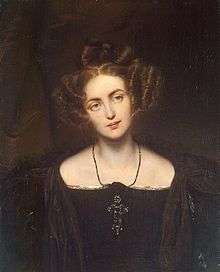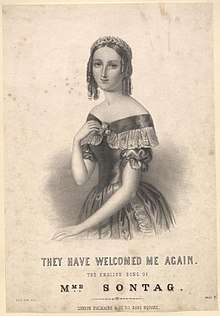Henriette Sontag
| Henriette Sontag | |
|---|---|
 Henriette Sontag as Donna Anna | |
| Born |
Gertrude Walpurgis Sontag 3 January 1806 Koblenz |
| Died | 17 June 1854 (aged 48) |
| Occupation | Opera singer (soprano) |
| Years active | 1823–1854 |
Henriette Sontag, born Gertrud Walpurgis Sontag, and after her marriage entitled Countess Rossi (3 January 1806 – 17 June 1854), was a German operatic soprano of great international renown. She possessed a sweet-toned, lyrical voice and was a brilliant exponent of florid singing.
Life
Sontag was born at Koblenz, Germany, as Gertrude Walpurgis Sontag, to the actor Franz Sontag and his wife, the actress Franziska Sontag (née Martloff, 1798–1865). Her brother was the actor Karl Sontag. She made her début at the age of 6. In 1823 she sang at Leipzig in Carl Maria von Weber's Der Freischütz and in December of that year created the title role in his Euryanthe. Her success was immediate. She was invited to be the soprano soloist in the first performances of Beethoven's Symphony No. 9 and Missa Solemnis on 7 May 1824; she was only 18 years old at the time. In 1825 she was engaged by the Königstädter Theater, Berlin.[1]
In 1826, she was engaged at the Paris Comédie-Italienne, where she debuted in the role of Rosina in Gioacchino Rossini's opera The Barber of Seville. She was also extremely successful in performance in England and Germany in the following years. When she visited Weimar, Goethe wrote a poem dedicated to her (Neue Siren). Around 1829 she married Count Carlo Rossi in secret, after which she left the stage until her husband's financial situation deteriorated.[1]
In 1849 she was encouraged by the impresario Benjamin Lumley to perform a season at Covent Garden Theatre. She proved to have fully retained her vocal powers. In 1852 she toured America, and in 1854 performed in Mexico. A day after singing in Lucia di Lamermoor, she contracted cholera, of which she died.[1]
Sontag is buried in Germany at St. Marienthal Abbey. Her sister Nina Sontag (1811–1879), originally also an opera-singer, had retired there as a nun in 1844.

Hector Berlioz wrote of Sontag:
"She unites all the qualities—although not in an equal degree—all like to find in an artist: sweetness never surpassed, agility almost fabulous, expression, and the most perfect intonation. On she carols, higher and higher, like a lark at "heaven's gate", so soft, so clear, so wonderfully distinct that, like the silver bell from the altar, it is heard through the pealing organ. But her principal merit, in our eyes, is the absence of 'rant'—the substitute of genius—in any shape whatever. She always SINGS, and does not depend on mere strength of lungs—erroneously called 'power'. She never strains her delicate organ—that sweet instrument so susceptible of every shade of expression. How fortunate for our young singers that, like the nuns in Meyerbeer's Robert le Diable she left the tomb of the seven ancestors, bestowed by the King of Prussia upon the Countess de Rossi, to teach them the wide difference between singing and screaming, and to show how we all, during the last ten years, have been listening to, and adoring false prophets."[2]
References
- Notes
- 1 2 3 Warrack (n.d.)
- ↑ Article on Sontag, "Sontag-iana", Dwight's Journal of Music, 28 August 1852, Volumes 1 & 2, quoting from Courrier des États-Unis.
- Sources
- Warrack, John (n.d.). "Sontag [Sonntag], Henriette (Gertrud Walpurgis)", Oxford Music Online, accessed 4 July 2017 (subscription required)
External links
![]()